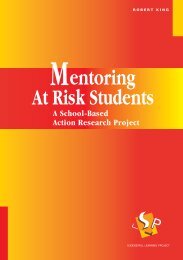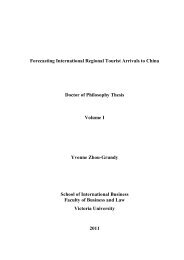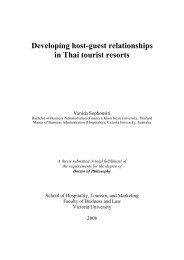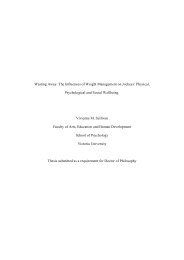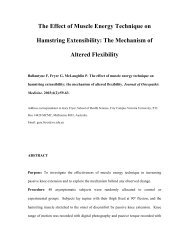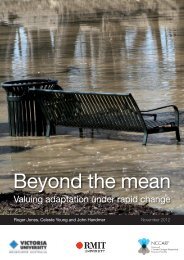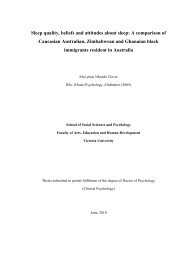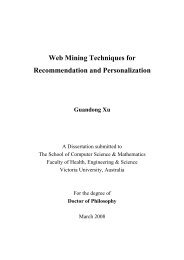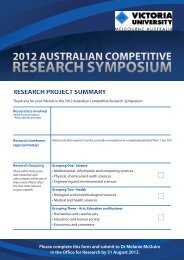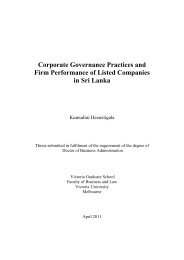Providing Education and Training for At Risk ... - Victoria University
Providing Education and Training for At Risk ... - Victoria University
Providing Education and Training for At Risk ... - Victoria University
- No tags were found...
You also want an ePaper? Increase the reach of your titles
YUMPU automatically turns print PDFs into web optimized ePapers that Google loves.
This emphasis on having the ‘right’ kind of teacher in programs <strong>for</strong> ‘at risk’ young people,which is evident in both the literature <strong>and</strong> in our field research, is clearly well founded because<strong>for</strong> most students interviewed <strong>for</strong> this project, the clincher <strong>for</strong> their continued involvementwas the caring <strong>and</strong> accessible attitude of the staff <strong>and</strong> the supportive learning environmentthey created.Another aspect of the teacher role is the issue of leadership. It was apparent that most of thesuccessful programs relied on the leadership, enthusiasm <strong>and</strong> commitment of one or two keypeople. There are clear dangers in this model. In some instances the “driver’s” worth had beenacknowledged by the system, <strong>and</strong> she/he had been promoted to another position - to thedetriment of the innovative program she/he was leading. There is a clear need to establish astructure at the outset, which will ensure leadership stability.The other danger of this leadership model is ‘burn out’. Staff undertaking dem<strong>and</strong>ingresponsibilities such as these need to be adequately supported. This may take the <strong>for</strong>m ofprofessional development in managing people <strong>and</strong> projects, adjustment of other responsibilitiesto provide real planning <strong>and</strong> organisational time, or the provision of administration or otherappropriate support. Voluntary <strong>and</strong> enthusiastic participation alone do not guarantee successfulimplementation of innovations. The role <strong>and</strong> responsibilities of program leaders must beacknowledged <strong>and</strong> they must be appropriately resourced.The above points raise clear resourcing implications if the implementation of theseprograms is to be successful. Structures must be put in place at the outset, which willensure adequate planning time, <strong>and</strong> regular, scheduled meetings of staff. A structurewhich ensures stability of leadership regardless of the inevitable movement of individualsin <strong>and</strong> out of the program is also essential.Principle 4: The orientation of the program moves beyond theparticular ‘risk’ to broader adolescent/ young developmentMost of the successful programs investigated in this project acknowledged the importance ofdealing with the whole person rather than focusing solely on the immediate curriculum content.Flinders Peak addressed the links between curriculum, welfare <strong>and</strong> discipline, while Box Hillintroduced a mentoring program, which involved students in setting personal goals. BlackwoodCentre <strong>for</strong> Adolescent Development provided a program which not only addressed academicneeds <strong>and</strong> included experiential learning strategies, but also focussed on the development ofstudent’s’ social competencies in self management, decision making, problem solving,communication, <strong>and</strong> resisting negative <strong>and</strong> limiting social influences. Schools such as Doveton<strong>and</strong> Footscray City have strong associations with community agencies <strong>and</strong> are able to engagethis expertise on a regular basis. Agencies such as Citymission <strong>and</strong> BEAT have good connectionswith schools <strong>and</strong> TAFE institutes <strong>and</strong> can provide off-site programs when on-site programsare not working <strong>for</strong> individuals.Outcomes identified by staff <strong>and</strong> students in these programs affirm the benefits of the holisticapproach to education <strong>and</strong> training <strong>for</strong> this group of young people. Staff at Flinders Peak haveattested to a 75% reduction in truancy <strong>for</strong> students in the PEAK program while also noticinga marked increase in enthusiasm toward being at school. Box Hill identified a more positive57




